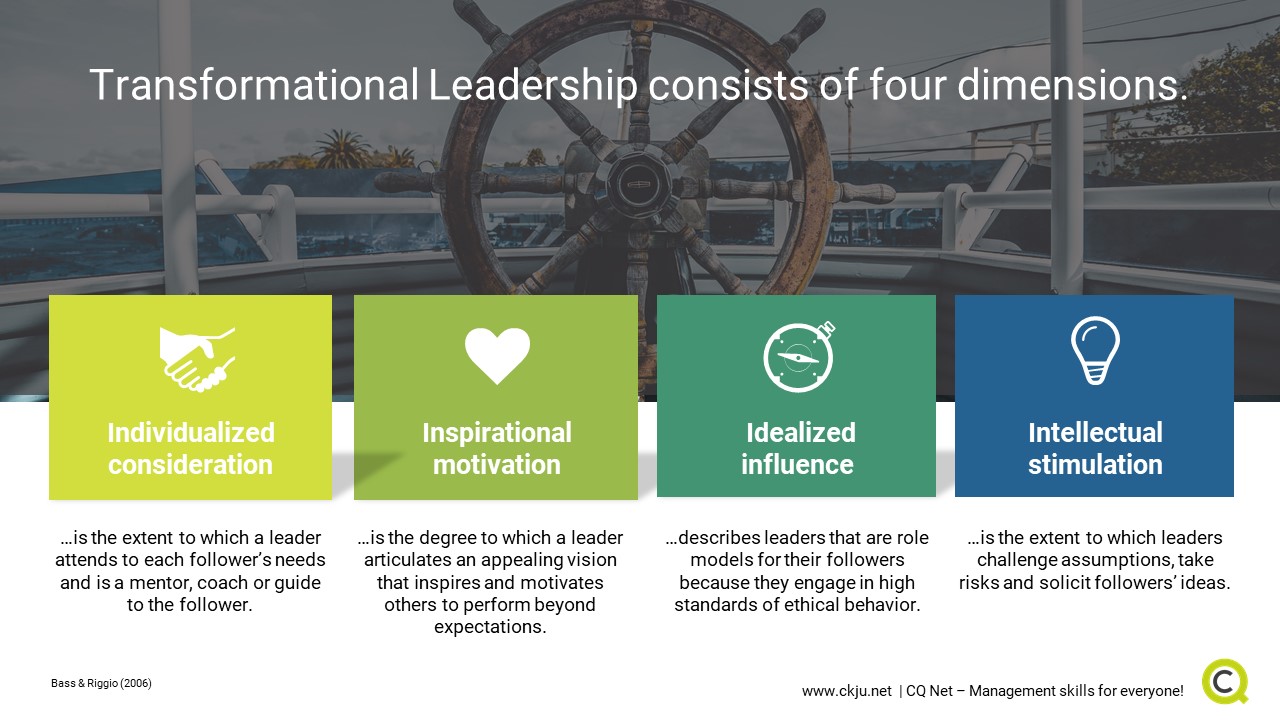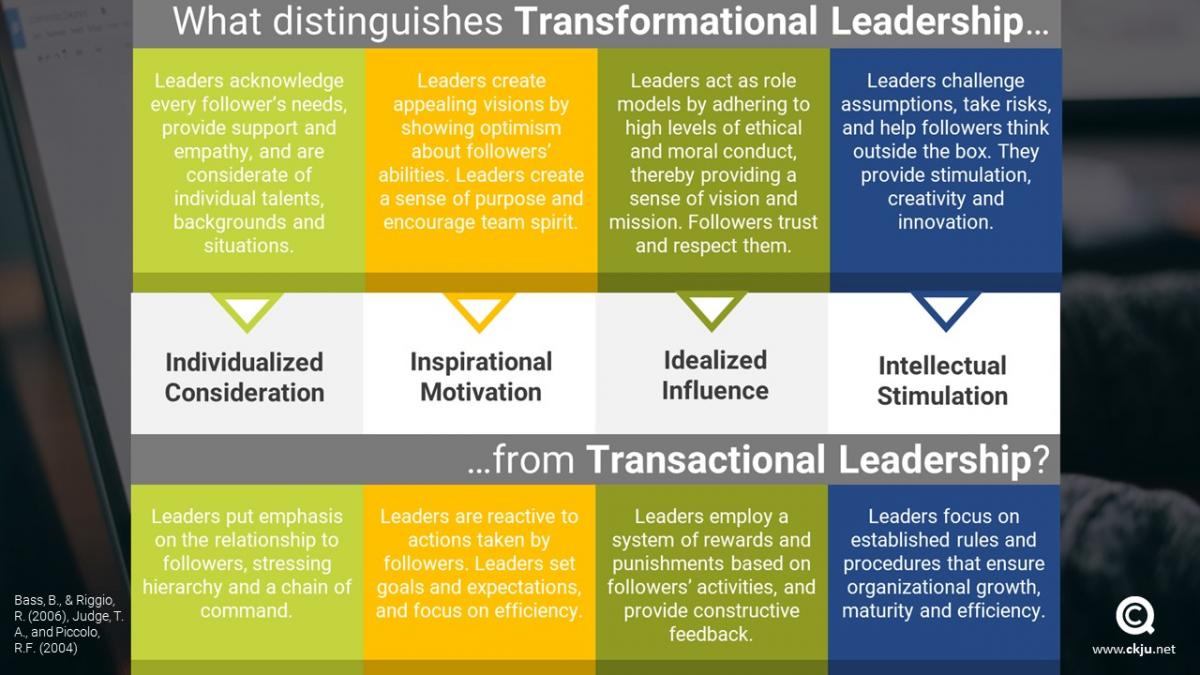- All Management Learning Resources
- Transformational leadership

Executive summary
In this CQ Dossier we describe the qualities of transformational leaders and how they gain commitment to their vision and the mission of the organization. We draw on the main theories of transformational leadership to present the key behaviors that distinguish transformational leaders from transactional leaders. In addition, we have a look at how transformational leaders show individualized consideration, intellectually stimulate their followers, provide inspirational motivation and idealized influence.
Contents
- Executive summary
- Transformational leaders guide followers through inspiration and motivation
- Transformational Leadership relies on charisma
- Transformational Leadership is comprised of four main components
- Transactional Leadership focus on deviation management and corrective action
- Transformational leaders are positive role models regardless of hierarchy
- Transformational Leadership increases (financial) performance
- Transactional Leadership shortcomings and weaknesses
- Key take-aways
- References & further readings
Transformational leaders guide followers through inspiration and motivation
Over the last ten years, researchers have focused on transformational leadership as a being an effective leadership strategy to implement within public and private sector organizations (Hassan & Hatmaker, 2014). Transformational leaders work with their employees to implement change.
Transformational leaders create a vision for their followers and guide the change through inspiration and motivation. They are excellent role models and their followers emulate many of their actions. They also inspire through activating follower self-efficacy so that followers believe that they can go beyond expectations (Barth-Farkas & Vera, 2014).
We describe the main dimensions of transformational leadership and explain those qualities that distinguish transformational leaders from managers who use a transactional leadership style. Finally, we provide recommendations on how best to cultivate a culture where transformational leadership flourishes and we introduce some of the shortcomings of transformational leadership and how to tackle them.
Transformational Leadership relies on charisma
There has been a proliferation in research on transformational leadership with charisma being the most important construct. The sociologist, Weber first used the term ‘charisma’ to describe a form of social authority and stated that transformational leaders derive their legitimacy through their behavior and character rather than through a formal position, rules, or tradition.
In fact, the term, ‘charisma’ means “endowed with the gift of divine grace” and imbues a person with referent power so that they gain legitimacy as a leader. Concern about a faltering world economy led scientists and practitioners to rediscover the concept of transformational leadership. Transformational leadership was viewed as a positive force to mobilize organizations.
Transformational Leadership is comprised of four main components
Instead of managers who continue to move organizations along historical tracks the new leaders must transform the organizations and head them down new tracks. What is required of this kind of leader is an ability to help the organization develop a vision and strategy of what it can be to mobilize the organization, to accept and work toward achieving the new vision and to institutionalize the changes that must last over time (Tichy & Ulrich, 1984).
This resurgence of interest in outstanding leadership generated a substantial body of theoretical and empirical investigation of transformational leadership. The main contributor to the field was Bernard Bass (Bass, 1985). Along with his colleague Bruce Avolio, they developed and refined a theory and measurement of transformational leadership that comprised of four main components.
Individualized Consideration
Individualized Consideration is the extent to which a leader attends to each follower’s needs and is a mentor, coach or guide to the follower. This leader listens to the concerns and needs of each follower and provides support and is empathic of each person’ situation and background.
When a leader shows individualized consideration they are also aware of the unique talents that each follower brings to the workplace and support them in developing and demonstrating these key skills and behaviors. This leads the follower to aspire to develop further and they show intrinsic motivation when performing their work.
Inspirational Motivation
Inspirational Motivation is the degree to which a leader articulates an appealing vision that inspires and motivates others to perform beyond expectations. Leaders who use inspirational motivation have high standards and expectation for their followers.
They are optimistic about follower ability to meet goals and they always provide meaning to their followers through showing the importance of all duties and responsibilities. In fact, they are able to motivate their followers to have a strong sense of purpose so they provide purpose and meaning to drive their group forward. This encourages followers to invest more effort in their tasks and to be optimistic about the future and to invest in their own abilities.
Team spirit is usually enhanced by this type of leadership. Here is an example of speech that was used in a research study by Howell and Frost and exemplifies transformational leadership (Howell & Frost, 1989, p250):
The result of this project could go a long way towards changing the way business schools train their students. We hope this project will have a direct effect on how managers are trained in the future. What you are doing today is going to have an impact on your own future. As you go through the exercise, I really want you to be as creative and imagine as you can ….Don’t be afraid to take risks. Trust your instincts.
Idealized Influence
Transformational leaders who show Idealized Influence are role models for their followers because they engage in high standards of ethical behavior. Followers identify with these leaders, and want to emulate them.
These leaders usually have very high standards of moral and ethical conduct and can be considered to doing the right thing. They are deeply respected by followers, who usually place a great deal of trust in them. They provide followers with a sense of vision and mission.
Intellectual Stimulation
Intellectual Stimulation is the extent to which transformational leaders challenge assumptions, take risks and solicit followers’ ideas. They recognize followers through stimulation, creativity and innovation.
The leader support and collaborates with the followers as they try new approaches and develop innovative ways of dealing with organizational issues.
The leader encourages followers to think things out on their own and encourages followers to think independently so that followers become autonomous.
Management skills newsletter
Join our monthly newsletter to receive management tips, tricks and insights directly into your inbox!
Transactional Leadership focus on deviation management and corrective action
These are the four main factors of Transformational Leadership. Transformational Leadership has been contrasted with Transactional Leadership (Bass, 1985). The active transactional leader, through an exchange with subordinates, emphasizes the giving of rewards if subordinates meet agree upon performance standards. The less active transactional leader practices avoidance of corrective action (management-by-exception) as long as standards are being met and is best depicted by the old adage, “if it ain’t broke, don’t fix it.”
Thus, active Transactional Leadership emerges from a rational-legal relationship, whereby leaders gain compliance from their followers through an exchange of goods. There is empirical evidence that transformational leadership is more effective than transactional leadership.
In contrast to managers who use transactional methods such as providing contingent rewards in exchange for effort, transformational leaders are more effective in mobilizing their followers to exert extra effort (Bass & Avolio, 1993). In the military, transformational leaders are more effective in leading teams than transactional leaders (Longshore, 1988).
Transformational leaders are positive role models regardless of hierarchy
Transformational Leadership is visible at all levels of an organizations. Managers can use empowering language to gain commitment from their subordinates. There is no doubt that CEOs who are transformational have a significant impact on the performance of their organization mainly because they are seen as positive role models whose behaviors are emulated throughout all levels of the organization (Waldman, Ramirez, House & Puranam, 2001). Successful CEOs also practice “management by walking around” and use language that is appropriate for a particular, individual, group, or department.
This ability to connect with others regardless of hierarchy is a behavior that transformational leaders practice on a daily basis. Transformational leaders also have close contact with their followers and are authentic in showing their strengths and weaknesses within the firm.
Transformational leadership has been observed at all levels of management. Transformational leadership can cross hierarchical echelons so is transparent on the shop floor as well as at the top of the hierarchical chain (Bass & Avolio, 1993).
Transformational Leadership increases (financial) performance
There is also empirical evidence that transformational leadership is important in helping to elevate the effectiveness and efficiency within organizations. Boas Shamir and his colleagues reviewed more than twenty studies and found that Transformational Leadership was positively associated with performance.
A meta-analysis that focused on the use of the Multifactor Leadership questionnaire, which measures Transformational Leadership, also found a positive association between Transformational Leadership and organizational effectiveness (Lowe et al., 1996).
In another study, presidents of 27 simulated business firms who were described as transformational had higher financial performance in their firms compared to those who were described as transactional (Avolio, Yammarino, & Bass, 1991). Transformational leaders are effective in the vision and mission that they disseminate throughout the organization.
In a survey of 183 entrepreneurs in the woodwork industry, Baum and colleagues found that company visions that were effectively written and communicated throughout the organization and contained attributes of future orientation and challenge, affected subsequent venture growth (Baum, Locke & Kirkpatrick, 1998).
Transactional Leadership shortcomings and weaknesses
You should be aware that Transformational Leadership and other leadership approaches that rely on a similiar set of assumptions (e.g. charismatic leadership and authentic leadership) have considerable shortcomings and weaknesses. We will have a look at three of these shortcomings and introduce some alternative leadership concepts you should be aware of.
Transformational Leadership is too static and oversimplifies corporate life
Transformational Leadership strongly relies on a set of rather static guidelines and principles such as the four Is. This makes Transformational Leadership an easy to understand and easy to apply concept. However, corporate life is usually much more complex and requires a leadership approach that is capable of dealing with this complexity (Marion & Uhl-Bien, 2001). Complexity leadership is an alternative leadership approach that focuses on the full range of social interactions in organizations instead of leader-follower relationships only.
Transformational Leadership overemphasizes the "Great Leader"
The epicentrum of Transformational Leadership is a strong, charismatic leader that steers the organizations through tough times towards an attractive future. This overemphasize on the positive outcomes generated by the "Great Transformational Leader" is another shortcoming of the Transformational Leadership approach (Alvesson und Einola 2019). One direction to mitigate this shortcoming is a shift in focus from individual leaders towards leadership teams. In addition, Transformational Leadership is part of the "positive leadership" tradition which has come under fire by practitioners and schoolars alike due to its overreliance on idelogies instead of scientific rigor (Alvesson und Kärreman 2016).
The Transformational Leadership model is flawed
Scholars have started to critize the theoretical foundation and operationaliziation of Transformational Leadership as flawed. One of those arguments is that the building blocks of Transformational Leadership lack a clear definition and are rather vague. In addition, van Knippenberg und Sitkin (2013) argue that tools to measure Transformational Leadership and its effects on (organizational) performance do not meet scientific standards in terms of validity.
In this CQ Dossier we focuse on the foundation of Transformational Leadership, those behaviors that differentiate transformational leaders from transactional leaders and shortcoming associated with Transformational Leadership. There are four main components of Transformational Leadership: Individualized Consideration, Intellectual Stimulation, Inspirational Motivation, and Idealized Influence. Each of these components are positively related to individual and organizational performance. Transformational leaders enable their followers to go beyond expectations whereas transactional leaders merely provide contingent rewards in exchange for effort and are less effective than transformational leaders.
Key take-aways
- Transformational leaders are visionary
- Transformational leaders attend to each follower’s needs
- Transformational leaders empower their followers to perform beyond normal expectations
- Transformational leaders are excellent role models
- Transformational leaders use intellectual stimulation to motivate followers to think outside the box
- Compared to Transactional leadership, transformational leadership is positively related to organizational performance
- Transformational Leadership has some shortcomings professionals and manager should be ware of
References & further readings
Alvesson, Mats; Einola, Katja (2019): Warning for excessive positivity: Authentic leadership and other traps in leadership studies. In: The Leadership Quarterly. DOI: 10.1016/j.leaqua.2019.04.001.
Alvesson, Mats; Kärreman, Dan (2016): Intellectual Failure and Ideological Success in Organization Studies. In: Journal of Management Inquiry 25 (2), S. 139–152. DOI: 10.1177/1056492615589974.
Avolio, B. J., Yammarino, F. J., & Bass, B. M. (1991). Identifying common methods variance with data collected from a single source: An unresolved sticky issue. Journal of Management, 173, 571-587.
Awamleh, R., & Gardner, W. L. (1999). Perceptions of leader charisma and effectiveness: The effects of vision content, delivery and organizational performance. Leadership Quarterly, 10, 345-373.
Barth-Farkas, F., & Vera, A. (2014). Power and Transformational Leadership in Public Organizations. International Journal of Leadership in Public Services, 10,4, 217-232.
Bass, B. M. (1985). Leadership and Performance Beyond Expectations. New York. NY: Free Press.
Bass, B. M., & Avolio, B. J. (1993). Transformational leadership: A response to critiques. In M. M. Chemers & R. Ayman (Eds.). Leadership theory and research; Perspectives and directions. San Diego, CA: Sage.
Baum, J. R., Locke, E. A., & Kirkpatrick, S. A. 1998). A longitudinal study of the relation of vision and vision communication to venture growth in entrepreneurial firms. Journal of Applied Psychology, 83, 43-54.
Hassan, S. & Hatmaker, D. M. (2014). Leadership and performance of Public Employees: Effects of the Quality and Characteristics of Manager-Employee Relationship”. Journal of Public Administration Research and Theory, 25, 4, 1127-1155.
Howell, J. M., & Frost, P. J. (1989). A Laboratory study of charismatic leadership. Organizational Behavior and Human Decision Processes, 43, 243-269.
Longshore, J. M. (1988). The associative relationship between transformational and transactional leadership styles and group productivity. Doctoral dissertation. Nova University, Fort Lauderdale, FL.
Lowe, K. B., Kroeck, K .G., & Sivasubramaniam, N. (1996). Effectiveness correlates of transformational and transactional leadership: A meta-analytic review. Leadership Quarterly, 7, 385-425.
Tichy, N. M., & Ulrich, D. O. (1984). The leadership challenge – A call for the transformational leader. Sloan Management Review, 59-68.
van Knippenberg, Daan; Sitkin, Sim B. (2013): A Critical Assessment of Charismatic—Transformational Leadership Research: Back to the Drawing Board? In: The Academy of Management Annals 7 (1), S. 1–60. DOI: 10.1080/19416520.2013.759433.
Waldman, D. A., Ramirez, G. G., House, R. J., & Puranam, P. (2001). Does leadership matter? CEO leadership attributes and profitability under conditions of perceived environmental uncertainty. Academy of Management Journal, 44, 134-143.
About the Author










